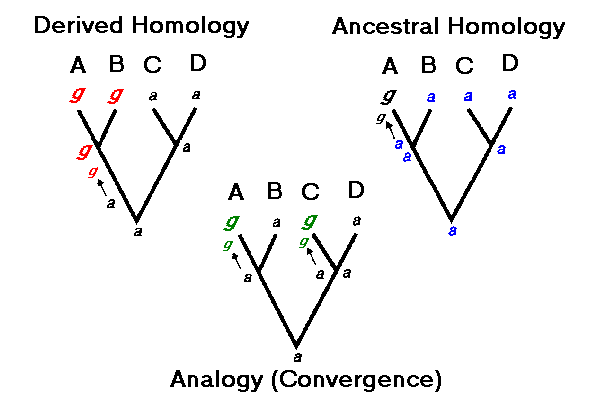i
Concepts of Homology
and Analogy applied
to nucleotide character states
The branching diagram shows the correct phylogenetic
relationships among taxa A, B, C, & D.
The plesiomorphic (ancestral)
character state is a, and the apomorphic (derived)
character state is g. The distribution
of a & g at three
different nucleotide positions illustrates the
concepts of homology and analogy as
applied to molecular data. The information content of each
position differs.
1 2 3
A g g g
B g a a
C a
a g
D a
a a
(Pos 1) Synapomorphy
(shared derived character):
the shared nucleotide state g
in A & B correctly indicates they are each
others closest relatives.
(Pos 2) Symplesiomorphy (shared ancestral character):
the shared nucleotide state a
in B, C, & D incorrectly suggests that
B is closely related to C & D. However,
the nucleotide state g in A
is an autapomorphy
(unique derived character),
and cannot be used to infer relationship to B, C,
or D.
(Pos 3) Convergence (analogy): the shared
nucleotide state g
in A & C incorrectly suggests that they are
closely related. This is sometimes called parallel evolution,
because the a  g change is the same in both
mutations. The term convergence is a bit
misleading, as the ancestral and derived character states in A
& C are not more similar afterward than before.
However, because (AB) and (CD) are in fact separate
clades, the g state
makes them appear more closely related than they actually are.
g change is the same in both
mutations. The term convergence is a bit
misleading, as the ancestral and derived character states in A
& C are not more similar afterward than before.
However, because (AB) and (CD) are in fact separate
clades, the g state
makes them appear more closely related than they actually are.
AN IMPORTANT DISTINCTION
between morphological & molecular character
states is that all bases of the same type look exactly alike,
whether they are analogous or homologous. Inspection of the
character itself will not reveal anything. In contrast, analogy or
homology of morphological structures such as wings
can often be distinguished readily.
